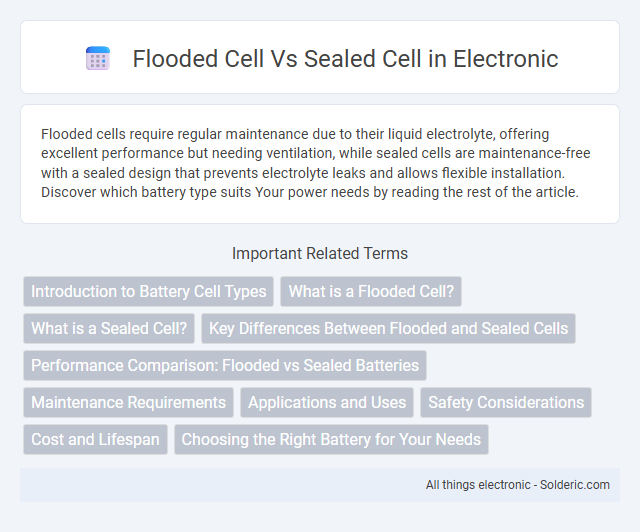Flooded cells require regular maintenance due to their liquid electrolyte, offering excellent performance but needing ventilation, while sealed cells are maintenance-free with a sealed design that prevents electrolyte leaks and allows flexible installation. Discover which battery type suits Your power needs by reading the rest of the article.
Comparison Table
| Feature | Flooded Cell Battery | Sealed Cell Battery |
|---|---|---|
| Design | Open vent, contains liquid electrolyte | Closed, gel or AGM technology |
| Maintenance | Requires regular electrolyte topping | Maintenance-free |
| Durability | Long lifespan with proper care | Good lifespan, less affected by vibration |
| Spill Risk | Higher, electrolyte can leak | Minimal, sealed design prevents leaks |
| Cost | Lower initial cost | Higher initial cost |
| Performance | Good performance with ventilation | Better performance in enclosed or mobile use |
| Applications | Automotive, backup power with ventilation | UPS systems, marine, RVs, portable devices |
Introduction to Battery Cell Types
Flooded cells, also known as flooded lead-acid batteries, contain a liquid electrolyte that requires regular maintenance such as checking water levels and ensuring proper ventilation. Sealed cells, including AGM (Absorbent Glass Mat) and gel batteries, are maintenance-free, spill-proof, and designed for use in confined or sensitive environments. Understanding these fundamental differences helps you choose the right battery type based on your application's maintenance capacity and operational conditions.
What is a Flooded Cell?
A flooded cell is a type of lead-acid battery where the electrolyte is in liquid form, freely covering the battery plates and allowing gases to escape during charging. This design requires regular maintenance, including electrolyte level checks and water refilling to prevent damage. Flooded cells are commonly used in automotive applications and backup power systems due to their reliability and cost-effectiveness.
What is a Sealed Cell?
A sealed cell battery is a type of lead-acid battery designed with a closed, maintenance-free casing that prevents the escape of electrolyte and allows for safe operation in various orientations. Unlike flooded cells, sealed cells employ absorbed glass mat (AGM) or gel technologies to immobilize the electrolyte, reducing the risk of leaks and corrosion. Your choice of sealed cell batteries ensures lower maintenance and enhanced safety for applications in automotive, backup power, and renewable energy systems.
Key Differences Between Flooded and Sealed Cells
Flooded cells contain liquid electrolyte that requires regular maintenance, such as topping off with distilled water, while sealed cells use a recombinant valve-regulated design that eliminates the need for maintenance. Flooded batteries typically offer better tolerance to overcharging and higher surge currents, ideal for heavy-duty applications, whereas sealed cells provide enhanced safety and are more resistant to leakage, making them suitable for portable and enclosed environments. The cost of flooded cells is generally lower, but sealed cells deliver longer lifespan and better performance in extreme temperature conditions.
Performance Comparison: Flooded vs Sealed Batteries
Flooded batteries offer superior performance in high-drain applications due to their ability to dissipate heat and allow for easy maintenance, such as water refilling. Sealed batteries, including AGM and gel types, provide enhanced safety and require minimal upkeep, making them ideal for environments sensitive to leaks or vibrations. Your choice depends on whether you prioritize raw power and serviceability or convenience and spill-proof design.
Maintenance Requirements
Flooded cells require regular maintenance, including checking electrolyte levels and adding distilled water to prevent sulfation and ensure optimal battery performance. Sealed cells, also known as valve-regulated lead-acid (VRLA) batteries, are maintenance-free due to their sealed construction, eliminating the need for water refilling and reducing the risk of acid spills. This low-maintenance design makes sealed cells ideal for applications where easy upkeep and safety are priorities.
Applications and Uses
Flooded lead-acid batteries are widely used in automotive starting systems, backup power supplies, and renewable energy storage due to their high surge current capability and cost-effectiveness. Sealed lead-acid batteries, including AGM and gel types, are preferred in applications requiring maintenance-free operation, such as UPS systems, medical devices, and mobility equipment. Their sealed design also enhances safety and allows installation in confined or sensitive environments.
Safety Considerations
Flooded cells require regular maintenance to prevent acid spills and hydrogen gas buildup, posing potential safety risks during handling and charging. Sealed cells, such as AGM or gel batteries, offer enhanced safety features by minimizing electrolyte leakage and reducing the risk of gas emissions, making them safer for enclosed or sensitive environments. Your choice should prioritize sealed cells for improved safety in applications where maintenance access is limited or exposure to hazardous conditions must be minimized.
Cost and Lifespan
Flooded cells typically cost less upfront compared to sealed cells, making them more budget-friendly for users seeking economical battery options. They generally have a longer lifespan when properly maintained due to their ability to be serviced and refreshed by adding water. Sealed cells offer convenience with minimal maintenance but usually come at a higher price and a shorter overall lifespan.
Choosing the Right Battery for Your Needs
Flooded cell batteries are cost-effective and ideal for applications requiring regular maintenance and water refilling, offering reliable performance with vented cells that release gases during charging. Sealed cell batteries, also known as AGM or gel batteries, provide a maintenance-free experience with a spill-proof design, making them suitable for vibration-prone or enclosed environments. Understanding your power demands and maintenance preferences will help you choose the right battery for your needs.
Flooded cell vs Sealed cell Infographic

 solderic.com
solderic.com